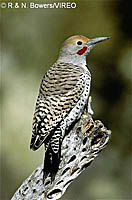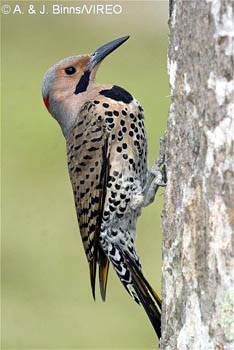Loading ...
Northern Flicker
The Northern Flicker (Colaptes auratus) is a large, common woodpecker that often forages on the ground for ants and grubs. In flight it displays a white rump and bright yellow (eastern) or salmon (western) undersurfaces on the wings and tail. In eastern North America the Northern Flicker is known as the "Yellow-shafted Flicker" and in the West as the "Red-shafted Flicker" (formerly separate species). The Northern Flicker is a year-round resident in most of the U.S., Canada, Cuba and parts of Mexico. The bird is bold and loud around humans. In the mating season it drums on telephone poles, transformers, metal roofs, and exposed wooden structures. Occasionally, a flicker oversteps its welcome by excavating a nest cavity a foot or more in depth in a cedar or redwood home. The Northern Flicker's vocalizations are a sharp "keaah" or a lengthy "flicker-flicker-flicker."
See all Northern Flicker photosField Marks:
The Northern Flicker has a long, spear-shaped bill, gray cap (brownish in the Red-shafted), black chest crescent, spotted breast, and brown and black-barred back. Male and female Yellow-shafted Flickers have a red crescent on the nape. The male Yellow-shafted has a black "mustache" mark and the male Red-shafted has a red mustache. (L. 12.5 in.)
Distribution:
The Northern Flicker breeds in Canada, eastern Alaska, the northern Great Lakes, and New England; it is a permanent resident in the remainder of the U.S (except part of Texas and Arizona where it winters), Cuba and parts of Mexico.
Similar Species:
 |
Gilded Flicker (all photos) The Northern Flicker is replaced by the Gilded Flicker in the Sonoran Desert of Arizona and northwestern Mexico. This species is similar to the Yellow-shafted except that it has an all-brown cap and a red mustache mark. |
Habitat & Nesting:
The Northern Flicker inhabits open woodlands, parks and forest edges where it excavates a more-than-two-inch, round hole in dead tree stumps. On occasion it ousts a Red-bellied Woodpecker from a partially excavated cavity.
More Information:
Northern Flickers migrate through Cape May, New Jersey in impressive waves. They consume the berries of poison ivy and other plants as well as ants and beetles. They often fall prey to Peregrine Falcons.

